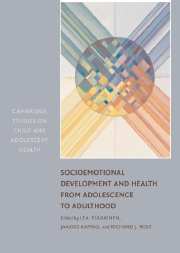Book contents
- Frontmatter
- Contents
- List of Contributors
- Preface
- Introduction
- PART I LONGITUDINAL AND BEHAVIORAL GENETIC APPROACHES
- PART II ADOLESCENT HEALTH-RELATED BEHAVIOR AND ADULT HEALTH
- 4 Body Size and Overweight From Birth to Adulthood
- 5 Pubertal Development and Health-Related Behavior
- 6 Genetic and Environmental Influences on the Initiation and Continuation of Smoking and Drinking
- 7 Self-Rated Health: Precursors and Implications
- PART III SOCIOEMOTIONAL BEHAVIOR IN EARLY ADOLESCENCE
- PART IV LIFE COURSE AND HEALTH
- Summary and Future Directions
- References
- Author Index
- Subject Index
4 - Body Size and Overweight From Birth to Adulthood
Published online by Cambridge University Press: 07 December 2009
- Frontmatter
- Contents
- List of Contributors
- Preface
- Introduction
- PART I LONGITUDINAL AND BEHAVIORAL GENETIC APPROACHES
- PART II ADOLESCENT HEALTH-RELATED BEHAVIOR AND ADULT HEALTH
- 4 Body Size and Overweight From Birth to Adulthood
- 5 Pubertal Development and Health-Related Behavior
- 6 Genetic and Environmental Influences on the Initiation and Continuation of Smoking and Drinking
- 7 Self-Rated Health: Precursors and Implications
- PART III SOCIOEMOTIONAL BEHAVIOR IN EARLY ADOLESCENCE
- PART IV LIFE COURSE AND HEALTH
- Summary and Future Directions
- References
- Author Index
- Subject Index
Summary
INTRODUCTION
Obesity has increased dramatically over the past decades worldwide in both sexes, all age groups, all ethnicities, and all educational levels. The International Obesity Task Force estimates that over one billion people around the world are now overweight; that is, they have a body mass index (BMI) of 25 kg/m2 or more. Obesity is fast approaching tobacco as the top underlying preventable cause of death.
Most notably, obesity has increased in the young. In the United States (Jolliffe, 2004) and in many European countries such as Finland (Kautiainen, Rimpelä, Vikat, & Virtanen, 2002), the prevalence of overweight in children and adolescents has doubled in the past two decades. From a public health perspective, one of the most significant concerns is that many of the overweight children grow up to be overweight or obese adults. In addition to the adverse effects on health, the social stigma related to obesity is substantial and already present at an early age for these children, underscoring the importance of preventive strategies for avoiding obesity and maintaining a healthy weight across all ages. Accordingly, longitudinal research is necessary to identify the determinants of growth and the critical periods in the development of obesity from birth through childhood and adolescence to adulthood. The FinnTwin16 (FT16) and the Jyväskylä Longitudinal Study of Personality and Social Development (JYLS) studies provide an opportunity to investigate these questions.
- Type
- Chapter
- Information
- Publisher: Cambridge University PressPrint publication year: 2006
- 1
- Cited by



